When it comes to creating vibrant and customizable lighting effects for a stage show, commercial illumination, and home decor, addressable LED strips are a fantastic choice. However, how to choose the right addressable LED strip can be a daunting task. You need to consider a variety of factors to ensure you select the best one for your project.
In this article, we will explore the key factors to consider when selecting addressable LED strips, the different types strips, and how to control them easily.
Table of Contents
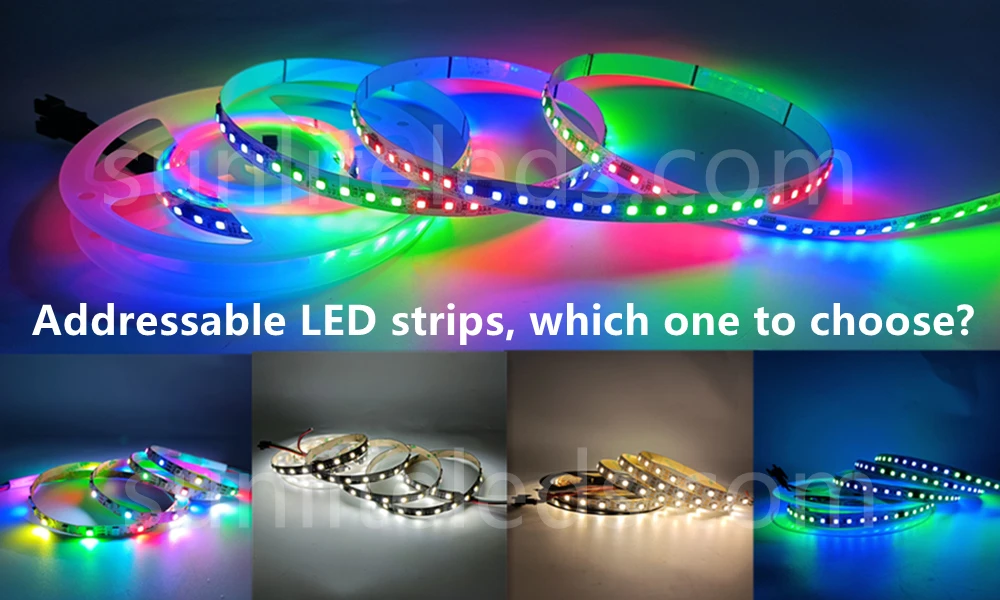
Top 6 Factors to Consider When Choose the Right Addressable LED Strip
In order to choose the right addressable LED strip, it’s important to consider the 6 basic factors: IC type, voltage, power consumption, color, LED density, and IP grade.
1. IC Type
Integrated Circuits (ICs) play a crucial role in addressable LED strips, so this will affect us to choose the right addressable LED strip.
All of the addressable LED strips can be divided into DMX512 LED strips and SPI LED strips according to the different transmission protocols.
DMX512 is an international standard transmission protocol, DMX512 ICs produced by different manufacturers may have different performances, but they all support the same protocol. For SPI LED strips, the different ICs mean they support different protocols. So when you use SPI LED strips, it is essential to choose the right IC type on the controller. The following are some common types of IC:
For DMX LED strip: UCS512, TM512
For SPI LED strip: SPI addressable LED strips can be divided into those with built-in ICs and those with external ICs.
WS2811, WS2813, WS2818, GS8208, UCS1903, UCS2903, UCS2904, UCS5603, UCS7604, TM1814, TM1934, FW1935, SM16703 addressable pixel LED strips are external ICs to control the LED strip in every 3 or 6 LEDs as a group.
WS2812, WS2813, WS2815, SK6812, SK6813, SK9822, APA102 digital LED strips are built-in ICs that can control each LED individually to achieve precise control.
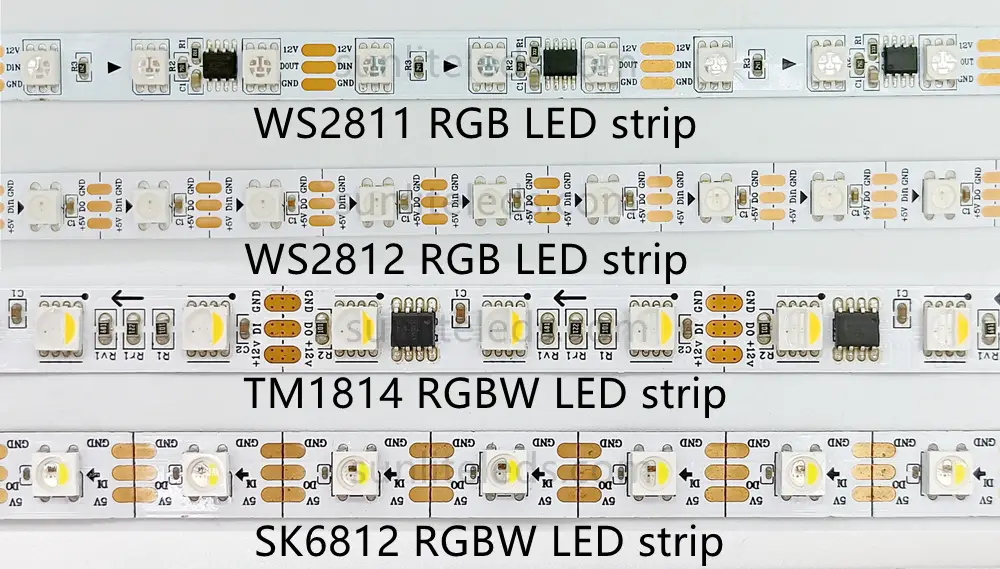
All of the programmable LED strips can also be divided into digital light strips with break-point resume and no break-point resume transmission. The break-point resume also known as the break continue function, means that if one IC or pixel on the strip is broken, the rest of the strip can still work normally without interference. For example, compare the WS2812B and WS2813 LED strips as the below image shows, the WS2813 LED strip can still work normally through the breakpoint. This feature ensures the stable performance of the light strip, making it suitable for large-scale lighting projects.
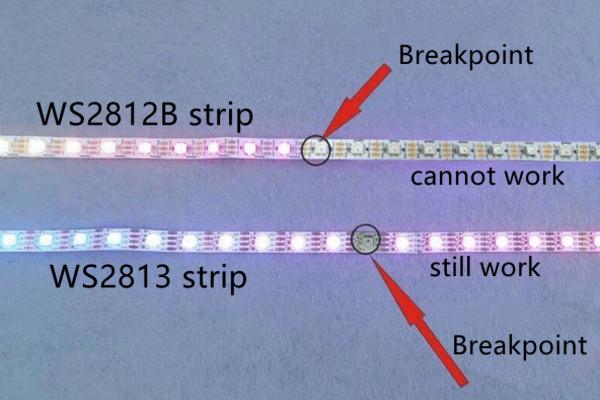
- SPI LED strips with break continue: WS2813, WS2815, WS2818, GS8208
- SPI LED strips without break continue: WS2811, WS2812, UCS1903, UCS2904, SK6812, TM1814, SK9822, APA102
All DMX LED strips use dual-data transmission, as you can see DAT A and DAT B on the strip, this special design has achieved the breakpoint resume.
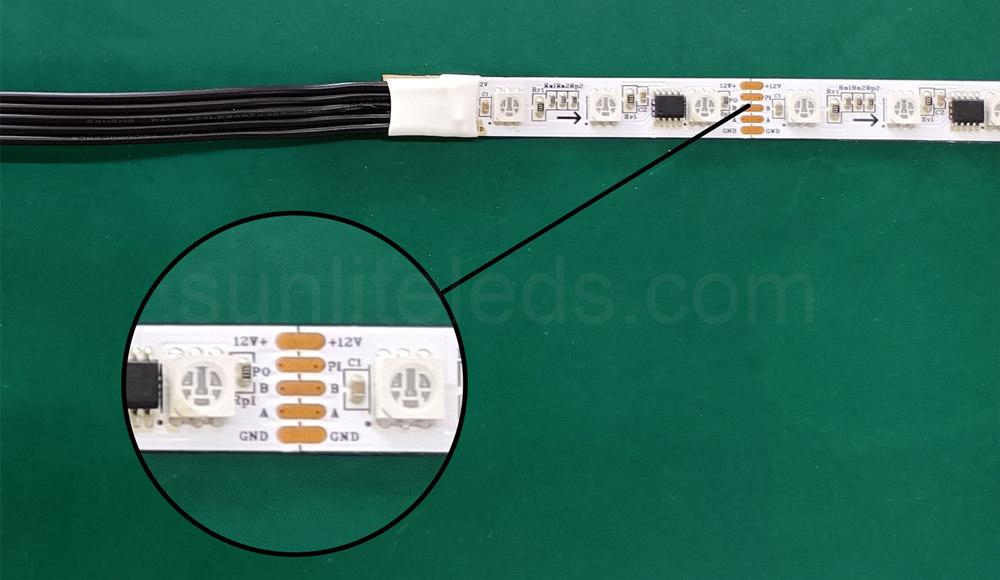
IC Specification Download:
2. Voltage
Voltage is an important factor to consider that affects us to choose the right addressable LED strip, the voltage of the power supply and the light strip should be the same.
The voltage of the digital LED strips is usually 5V, 12V, and 24V. When choosing the voltage, the key factor you need to consider is the voltage drop. Generally speaking, the lower the voltage, the more severe the voltage drop.
What is voltage drop?
Voltage drop refers to the decrease in voltage that occurs when electrical current flows through resistors in an electrical circuit. When current flows through a conductor, it encounters resistance, which converts some of the electrical energy into heat. According to Ohm’s law, voltage (V) is equal to the product of current (I) and resistance (R): V = I × R. Therefore, as the current passes through a resistance, the voltage across that resistance decreases.
In the case of power supply at one end, the strip light near the power supply is the brightest. As the transmission distance increases, the current flows through more resistors, the voltage gradually decreases, and the end of the light strip will be dim or even unable to light up.
It is essential to consider voltage drop because excessive voltage drop can lead to reduced lighting efficiency, inadequate performance of LED strips, and potential damage to sensitive components.
How to solve the voltage drop problem?
To minimize voltage drop, here are two ways: (1) reducing the length of the conductors or (2) increasing their cross-sectional area. To solve the voltage drop problem, we usually power the LED strip at both ends every 5 meters or 10 meters. This is the reducing the length of the conductors.
Or you can choose LED strip lights with thicker PCB. The thicker the PCB, the larger the cross-section of the copper and the more current can flow to reduce the voltage drop. This is increasing their cross-sectional area. SuntechLite has developed the 20m no voltage drop strips for large spaces lighting: UCS2904 RGBW LED strip, GS8208 individual control RGB LED strip, SK6812 individual control RGBW LED strip.
Here is a video to explain the LED strip voltage drop and how to solve the voltage drop problem:
3. Color
Color plays a crucial role in lighting effects, choose the right addressable LED strip including deciding which color to use.
For addressable LED strip lights, there are various colors to choose from. Below are the common colors to select:
- For white lighting:
Addressable white: warm white, cool white, daylight
Addressable WWA CCT: warm white+cool white, warm white+daylight, cool white+daylight - For RGB lighting:
Red, Green, Blue, RGB, RGBW, RGB+warm white, RGB+warm white+daylight
In addition to these basic colors, we can also adjust the brightness and mix the basic colors with the controller to display much more magic colors!
4. Power Consumption
It’s important to consider the power consumption to choose the right addressable LED strip. This helps ensure that the power supply or wiring can handle the load and prevents overloading. In the long run, this allows for estimating the energy efficiency and operational costs of using the LED strip.
The power consumption of an addressable LED strip is related to the density of the strip, the type of LED and its brightness. The higher the density of LED beads in the light strip, the larger the LED beads, the higher the brightness, so the higher the power.
5. LED Density
LED density decides the lighting uniformity and brightness, this factor helps us choose the right addressable LED strip.
LED density refers to the number of LEDs per meter on the strip. Higher LED density provides a more uniform and brighter lighting effect. Common digital LED lights on the market are 30leds/m, 60leds/m, and 144leds/m.
SuntechLite has designed some special addressable LED strips with a unique density for meeting diverse lighting needs: RGB 72leds DMX LED strip, RGB 120leds DMX LED strip, RGB DMX individually controlled LED strip, WS2811 96leds RGB LED strip, WS2815 66leds White LED strip…
6. IP Grade
To choose the right addressable LED strip, we need to confirm the dustproof and waterproof requirements.
IP grade, also known as IP rating or IP code, indicates the resistance to dust and moisture of a programmable LED strip. The common IP grades of addressable SMD LED strips are IP20, IP54, IP65, IP67, IP68. If you want to use the strips indoors, you can use IP20 or IP54 strip lights. If for outdoor use, IP65 or IP67 for different environmental conditions. The IP68 grade is specially designed for underwater lighting applications.
Types of Addressable LED Strips
Depending on the voltage, programmable LED strips can be divided into 5V, 12V, and 24V. You can select the suitable voltage pixel LED strip here:
According to the color difference, the addressable digital LED strip can be classified as addressable RGB LED strip, addressable RGBW LED strip, addressable white LED strip, addressable WWA CCT LED strip.
Due to the different applications, flexible digital LED strips can be categorized as Madrix Artnet LED strips, individually controlled LED strips, thin addressable LED strips, addressable UV LED strips, etc.
As we have mentioned earlier, there are two main types of addressable LED strips according to the different communication protocols: SPI LED strips and DMX512 LED strips.
SPI LED Strip
SPI (Serial Peripheral Interface) LED strips are widely used and offer excellent control and flexibility. Within the SPI LED strip category, several ICs are commonly used, including WS2811, WS2812, WS2813, TM1814, and SK6812.
WS2811 vs WS2812
WS2811 and WS2812 are two popular types of SPI LED strips. The main difference between them is the IC. WS2812 is an integrated IC, making it easier to control individual LEDs on the strip. On the other hand, WS2811 is an external separate IC, making it more robust and reliable and easier to repair if an LED fails.
Read more: WS2811 vs WS2812 compare
WS2813 vs WS2815
WS2813 and WS2815 are upgrades of the WS2812. They both feature dual-signal wires, allowing for continued operation even if one LED fails. The WS2815 operates at 12V, unlike the WS2813 which operates at 5V, offering a longer run length.
Read more: WS2813 vs WS2815 compare
TM1814 vs SK6812
TM1814 is a 4-channel IC LED strip that’s more color-accurate and has a high PWM frequency, reducing flicker. SK6812 is a 3-channel RGBW LED strip that has a dedicated white channel, offering better white light than mixed RGB.
Read more: TM1814 vs SK6812 Difference
DMX512 LED Strip
DMX512 LED strips use the DMX (Digital Multiplex) protocol for control, offering higher flexibility in creating complex lighting effects. These strips are commonly used in professional lighting setups, such as stage lighting and architectural lighting.
DMX512 vs SPI, What Is the Difference
DMX512 and SPI are two different protocols used for controlling addressable LED strips. DMX512 is a widely adopted standard in professional lighting control. SPI is a communication protocol used for controlling other addressable LED strips.
DMX512 is usually used for professional stage lighting and can control more channels, while SPI is commonly used for smaller projects and is easier to set up.
Want to know more detailed differences? Please click: DMX vs SPI LED strip
How to Control Addressable RGB LED strips Easily?
Controlling addressable RGB LED strips is made easy through various methods. The most common approach is by using a microcontroller or LED controller. These devices allow you to program and control the LED strip, adjusting colors, patterns, and brightness levels. Additionally, you can use software applications or smartphone apps to control the LEDs wirelessly via Bluetooth or Wi-Fi connections.
Please note that the DMX addressable LED strips need to set addresses before controlling them. The following left video will guide you to set DMX address. And the right video shows how to fast connect and control DMX LED strip lights.
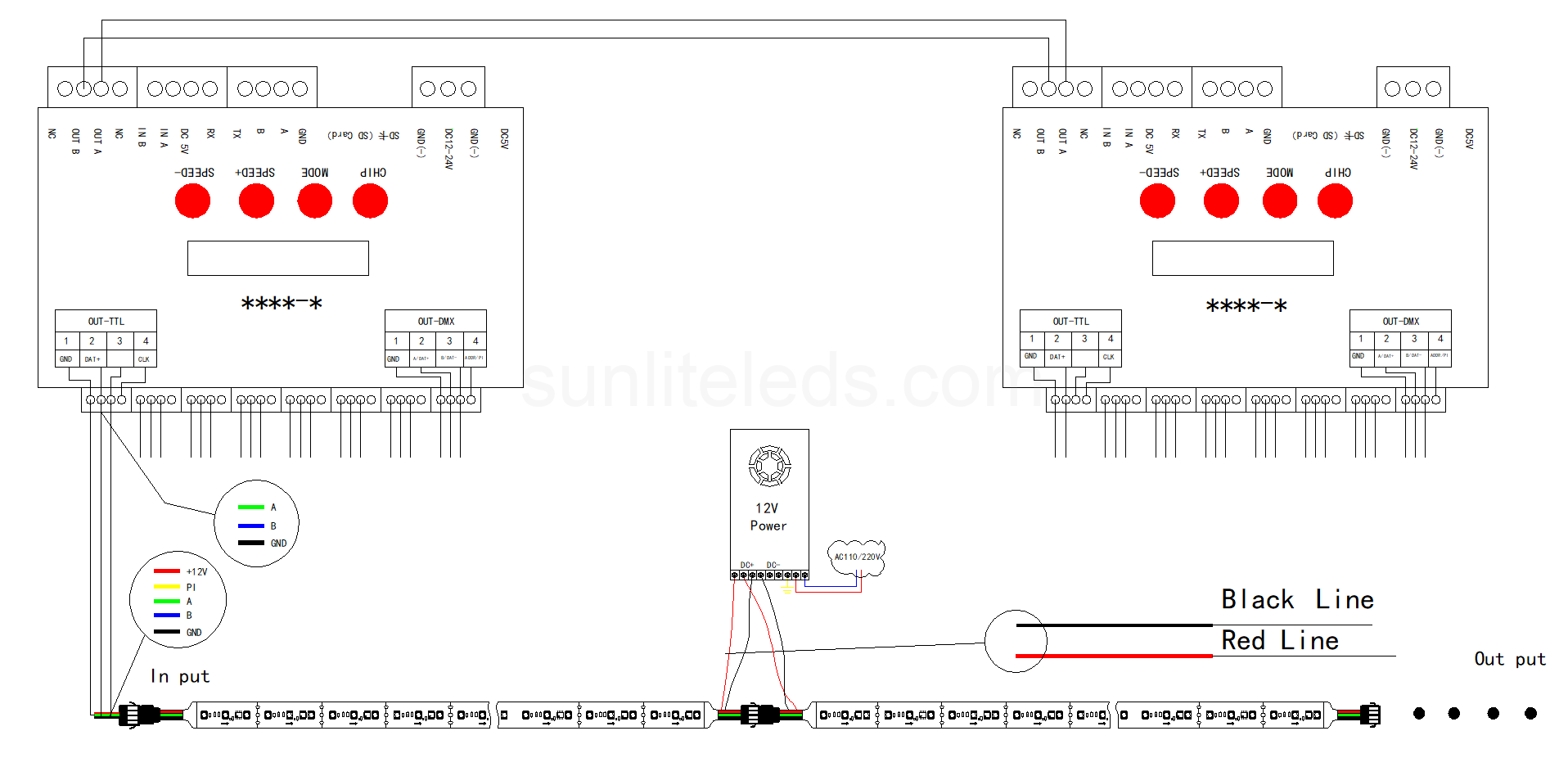
DMX RGB LED strip wiring diagram
For SPI addressable LED rope lights, the connection and control methods are similar. Please check how to control WS2811 and WS2815 LED strips in the below videos.

WS2811 LED strip wiring diagram

WS2815 LED strip wiring diagram
If you want to know more details, please click: connect and control addressable LED strips
Where to Buy Addressable LED Strip?
To choose the right addressable LED strips, it is crucial to find a reliable and reputable supplier. Look for suppliers that offer high-quality products, good customer support, and competitive pricing. Considering the product quality, price, later maintenance costs and technical services, it is best to find a professional and reliable manufacturer.
SuntechLite is a professional LED strip lights manufacturer, and we always put product quality first, and are dedicated to establishing long-term and friendly cooperation with our regular and new customers.
We use thicker PCB to minimize the voltage drop, and apply authentic resistor and double capacitor to protect the lCs and stable signal transmission. Please download the Suntech LED Strip Advantages profile to see more advantages.
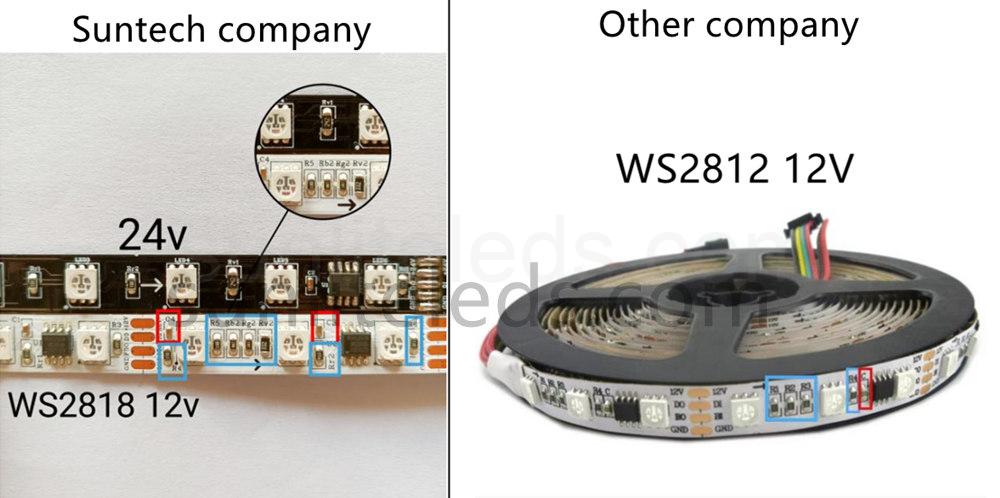
To ensure quality, we design the PCB ourselves, you can click to check the PCB design details of addressable LED strips.
Choose SuntechLite, you will obtain quality addressable LED rope lights with factory price, matching LED strip controller, control and installation guidance. If you need any help in lateral maintenance, welcome to contact us!
What Is an Addressable RGB LED Strip?
An addressable RGB LED strip consists of RGB LED, control IC, data and power wires, circuit, resistor and capacitor. For built-in IC strips, each LED has a built-in microcontroller, allowing for precise control over its color and brightness. For external IC strips, there is an IC driver for every 3 or 6 LEDs, which can be controlled in groups.
How does addressable LED strip work?
Addressable LED strips work by having a small chip integrated into each LED or separately installed out of LEDs. The IC receives instructions and data from a controller and then sends specific commands to each LED, instructing them on the desired color and intensity. This communication happens through a data line connected to each LED.
What can you do with addressable LED lights?
- Dynamic color-changing effects for ambient lighting
- Animated patterns for gaming setups and home theaters
- Accent lighting for architectural features and decorations
- Visual feedback in interactive installations
- Synchronized lighting effects for music and events
Difference Between Addressable LED Strips and Non-Addressable LED Strips
The main difference between addressable and non-addressable LED strips lies in their control capabilities. Addressable LED strips allow for controlling each small segment of LED independently, offering precise control over colors and effects, while non-addressable LED strips only allow you to control the entire strip as a unit.
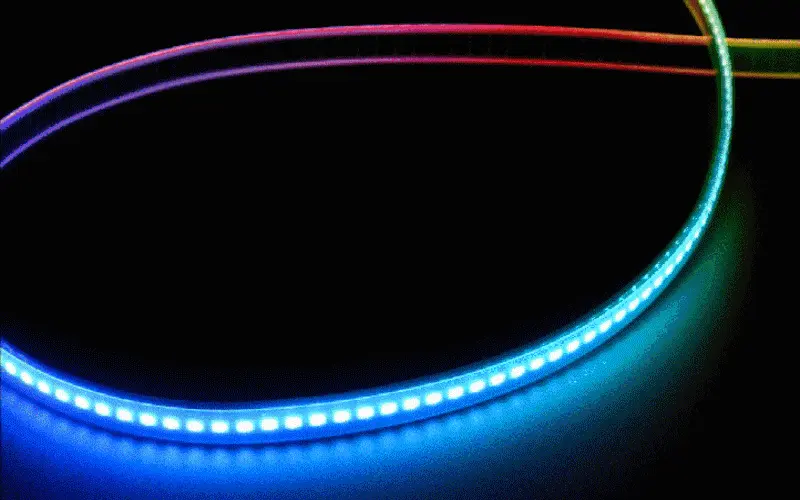
Addressable RGB LED Strip
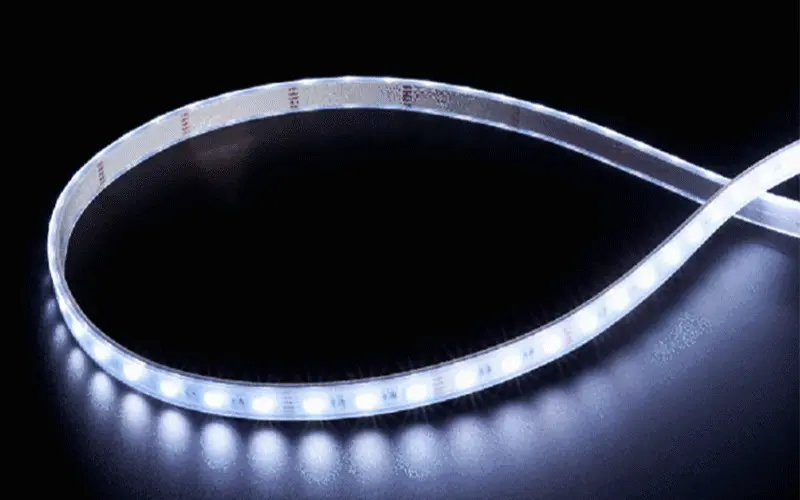
Regular RGB LED strip without IC
Custom Programmable LED Strip
If you have specific requirements for your lighting project, you can opt for custom programmable LED strips. These strips can be tailored to your needs, including strip length, PCB color, LED density, color configuration, and control options, and custom logo service is available. What’s more, we can program for you if you want to achieve a specific lighting effect.
Working with SuntechLite, you can design a custom solution that perfectly matches your project’s specifications.
FAQs
1. Can I cut my addressable LED strip?
Yes, addressable LED strips can be cut along the marked lines without damaging the rest of the strip.
2. Can addressable LED strips be synced with music?
Yes, the SP series controllers allow you to sync the LED lights with music, providing dynamic lighting effects based on the rhythm and beats.
3. How can I control addressable LED strip lights?
Addressable LED strip lights can be controlled through various methods, such as a dedicated remote, a smartphone app, or a computer. More advanced users can also use microcontrollers like Arduino or Raspberry Pi for more complex control.
4. What types of effects can be achieved with addressable LED strips?
Because addressable LED strips can be controlled by each pixel, a wide range of effects can be achieved. These include color changing, chasing, waving, flashing, fading, and more. With the right programming, any effect you can imagine is possible.
5. Do Addressable LED Strips Require Special Power Supplies?
Addressable LED strips typically require a 5V, 12V, or 24V power supply, but always check the specifications of your particular strip. The power supply must also be capable of supplying enough current for all the LEDs on the strip.
Conclusion
Choose the right addressable LED strip requires a good understanding of your lighting needs, the environment where the strip will be installed, and the technical specifications of the LED strip. By considering factors like voltage, power, color, IC type, LED density, and IP grade, you can ensure that you select the best LED strip for your project. Whether it’s for home decoration, entertainment lighting, or a commercial display, addressable LED strips can provide you with a wide array of vibrant and dynamic lighting effects.
